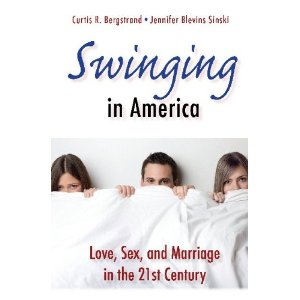
New York: Praeger, 2009, 203 pp., $44.95.
Click on the cover to buy from Amazon
Reviewed by:
Dawn Marie Reid
Department of Psychology
University of Saskatchewan
Swinging in America provides informative and entertaining excerpts gleaned from questionnaires that were anonymously filled out and submitted by swingers (mostly from the U.S., although some are from Canada and the UK). Bergstrand and Sinski contend that there are two ways to study swinging: participate in the activity and give an insider’s perspective or view it from outside and, in so doing, maintain “objectivity.” The authors make it clear that they do not participate in the swinging lifestyle but, instead, are drawing on years of sociological research about this topic. The authors acknowledge that the preconceived notions the general public holds towards swingers and other individuals participating in alternative lifestyles such as open marriages, polyamory, and polyandry are that persons engaging in such practices are distasteful and undermine the traditional monogamous family unit that has been held as ideal for decades. Bergstrand and Sinski report that the key purposes of the book are to describe the swinging lifestyle for those that wish to learn more about it and to ascertain whether alternative lifestyle choices like swinging will be considered more acceptable and even ordinary in the future.
Swinging in America is divided into two parts: the first part discusses the subcultures of swinging; the alleged beginnings of swinging; profiles of the “typical” swinger; what swinging involves, and how it affects those that participate in it. The second section discusses whether swinging is a viable mainstream lifestyle choice.
Part one presents many statistics in nicely laid out tables that compare the sample of swingers who completed anonymous web-based surveys to a general population sample that was recruited as a part of a governmental survey. To serve as the comparison group, the authors used data from the University of Chicago’s General Social Survey (GSS), and took 41 questions from the same survey to compare swingers’ attitudes to those of the general public. These comparisons indicate that swingers are everyday people: they are mostly white, middle-aged, and middle income Americans. Further, the swingers that were sampled were slightly less racist, less sexist, less jealous, and less homophobic than those in the general population.
It should be noted that, throughout part one, the authors are rather self-congratulatory. They refer to their research as “the largest and most comprehensive study of this group to date” (p. 13), and discuss the importance of their work – at least once – in all of the chapters in this section of the book. Further, repetition is problematic in part one. The key observation that swingers do not conform to stereotypes endorsed by the general public could be expressed more concisely.
The second part of the book is rife with discussions about how we live in a monocentric society and whether that can be changed. It was not always clear how swinging was related to the topics that were being discussed (e.g., couples counseling and therapy sessions, family dynamics, etc.). There is a chapter that examines how the Supreme Court has contributed to the construction of moral architecture that is unaccepting of sexuality and sexual practices outside of monogamy. There also was a lengthy section on jealousy. The inclusion of the latter was surprising because the authors had mentioned in part one that jealous individuals seldom participate in swinging.
In conclusion, the narrative quotes that were provided by swingers on the anonymous questionnaires are insightful and reflect the authors’ key points: swingers are “regular” people; swinging is not for everyone; and there are certain unwritten rules of etiquette that should be followed. Readers that may be interested in this book include social scientists, students studying sexuality, and those wishing to learn more about non-monogamous lifestyles.